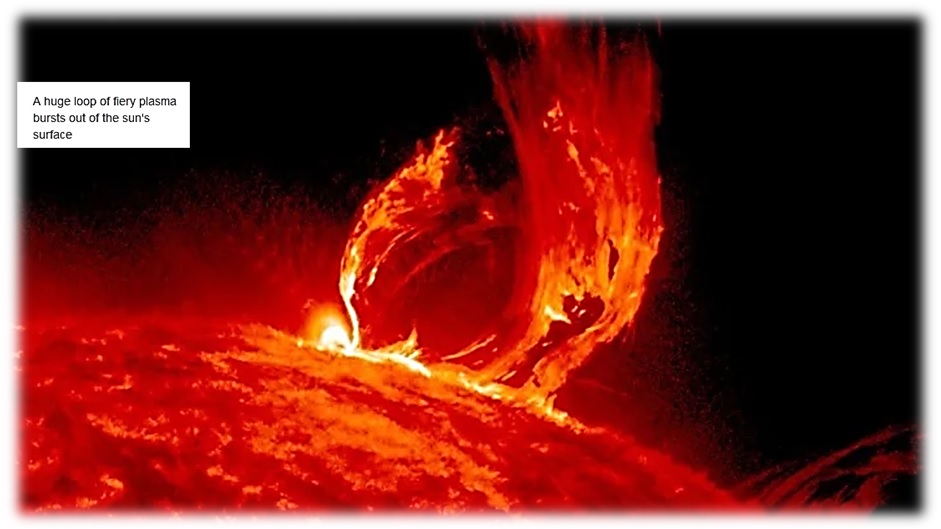
و اینک آخرالزمان
به نام خدای مهربان - ارائه مطالب و مقالات آخرالزمانی
و اینک آخرالزمان
به نام خدای مهربان - ارائه مطالب و مقالات آخرالزمانیSUN OUTBURST - طغیان خورشید (انفجار عظیم خورشیدی و تاثیر آن بروی زمین-ماه-مریخ)
مقاله سوم
3
Massive solar explosion
felt on Earth, the moon and Mars simultaneously for the 1st
time ever On Oct. 28, 2021,
a huge burst of plasma and magnetized particles erupted from the sun.
The massive solar outburst washed over Earth, the moon and Mars, bathing them
in radiation.
And, for the first time, instruments on all three bodies measured the same
event almost simultaneously.
On Mars, the European Space Agency’s ExoMars Trace Gas Orbiter (TGO) and NASA's
Curiosity rover registered the influx of energized particles.
On the moon, these particles were picked up by the Chinese National Space Administration's
Chang'e - 4 and
NASA's Lunar Reconnaissance Orbiter (LRO).
And closer to home, the German Aerospace Center's Eu:CROPIS satellite detected
the radiation from low Earth orbit. The effects of this solar hat trick were
reported Aug. 8 in the journal Geophysical Research
Letters. Understanding such events, known as
coronal mass ejections (CMEs), is crucial for future space exploration,
including planned missions to send astronauts to Mars and to establish a
scientific outpost on the moon.
On Earth, our magnetic field acts as a shield against most dangerous solar outbursts.
But the moon and Mars lack this protective magnetosphere, which means that a
lot more radiation makes it to their surfaces.Related: Solar
maximum could hit us harder and sooner than we thought. How dangerous will the
sun's chaotic peak be?
All that radiation can
have a negative impact on astronauts.
Exposure to high doses of radiation can lead to skin irritation, nausea, blood
disorders, weakened immunity and even cancer, according to a 2014
study published in the journal Life.
In acute cases, it can cause burns and neurologic degeneration.
A dangerous dose is considered to be around 700 milligray (1 gray being one unit of radiation).
Fortunately, the Oct. 28 CME was
much weaker than that, only clocking in at around 31
milligray — but CMEs become both more frequent and more intense as the
sun approaches the peak of its 11-year
solar activity cycle, which could begin as soon as the end of 2023.
The new study found that
Earth's magnetosphere and atmosphere rendered the radiation from the event
negligible by the time it reached our planet's surface. Mars's surface got
about one-30th of the initial dose thanks to
buffering effects from its atmosphere. But just over half of the initial dose
of radiation from the CME hit the moon's surface.
While this particular CME event wasn't strong enough to potentially sicken a
human, half of the radiation from a larger outburst could be deadly. Studying
where and how CMEs hit bodies beyond Earth could help scientists develop the
shielding necessary to protect future astronauts.
"Space radiation can create a
real danger to our exploration throughout the Solar System," Colin Wilson,
a project scientist on ExoMars TGO, said in a statement. "Thanks to data
from missions like ExoMars, we can prepare for how best to protect our human
explorers."

انفجار عظیم خورشیدی و آثار آن بر روی زمین – ماه – مریخ
انفجار عظیم خورشیدی که به طور همزمان روی زمین، ماه
و مریخ برای اولین بار در 28 اکتبر 2021، رخ داد، شامل پلاسما و ذرات مغناطیسی
فوران کرده از خورشید بود.آثار این طغیان عظیم خورشید بر روی زمین، ماه و مریخ
نشسته و آنها را غرق در تابش(تشعش) نمود و برای اولین بار، ابزارها و کاوشگرها(تحقیقاتی – مطالعاتی) روی هر سه (زمین – ماه – مریخ) تقریباً به طور همزمان یک رویداد را اندازه گیری کردند.در مریخ، مدارگرد "اگزومارس" متعلق به آژانس فضایی اروپا و همچنین مریخ نورد "کنجکاوی" متعلق به ناسا، هجوم
ذرات پر انرژی را ثبت کردند.
در سطح ماه، این ذرات
توسط کاوشگر "Chang'e-4" متعلق به اداره ملی فضایی چین و همچنین مدارگرد شناسایی ماه ناسا (LRO) برداشته شدند و درفاصله ای نزدیکتر به زمین ،
ماهواره Eu : CROPIS متعلق به مرکز هوا فضای آلمان تابش را از مدار پایین زمین شناسایی کرد. نتایج و گزارش مطالعه روی اثرات این هتریک خورشیدی در 8 آگوست 2022 در مجله Geophysical Research Letters به چاپ رسیده است.درک چنین رویدادهایی که به عنوان پرتاب جرم تاجی (CME ; Coronal Mass Ejection) شناخته میشوند، برای اکتشافات فضایی آینده، از جمله
مأموریتهای برنامهریزیشده برای ارسال فضانوردان به مریخ و ایجاد یک پایگاه علمی
در ماه بسیار مهم است.
در زمین، میدان
مغناطیسی ما در مقابل بیشتر طغیان های
خورشیدی خطرناک، به عنوان سپری قدرتمند عمل می کند، اما ماه و مریخ فاقد این "مگنتوسفر" محافظ هستند و این
بدان معناست که تشعشعات بیشتری به سطح آنها میرسد.
مطالب مرتبط: حداکثر خورشیدی می تواند سخت تر و زودتر از آنچه فکر می کردیم به ما ضربه بزند. در این دوره، قله آشفته خورشید(حداکثرخورشیدی) چقدر خطرناک خواهد بود؟
تمام آن تشعشعات می تواند تأثیر منفی بر فضانوردان بگذارد.طبق مطالعه ای که در سال 2014 در مجله Life منتشر شد، هشدار داده شد که قرار گرفتن در معرض دوزهای بالای تابش(تشعشعات رادیواکتیو و ذرات مشابه) میتواند منجر به ؛
- تحریک پوست
- حالت تهوع
- اختلالات خونی
- تضعیف سیستم ایمنی و حتی سرطان شود.
و در موارد حاد نیز می تواند باعث سوختگی و "دژنراسیون عصبی" شود.
مقدار دوز خطرناک تابش در حدود 700 میلی گِرِی(واحد سنجش تابش) درنظر گرفته می شود.
(gray واحد سنجش تابش است و هر گِرِی معادل یک واحد تابش می باشد.)
خوشبختانه، CME 28 اکتبر 2021 بسیار ضعیف تر از آن بود(در حدود 31 میلی گِرِی بود)
اما CME ها با نزدیک شدن خورشید به اوج چرخه فعالیت خورشیدی 11 ساله خودکه به زودی آغاز می شود(تا پایان سال 2023)، هم فراوان تر و هم شدیدتر می شوند.
مطالعات اخیر نشان داد که "مگنتوسفر" و "اتمسفر" زمین، اثر تابشی CME ها را هنگامیکه به سطح سیاره ما میرسد، ناچیز و اندک می نمایند.